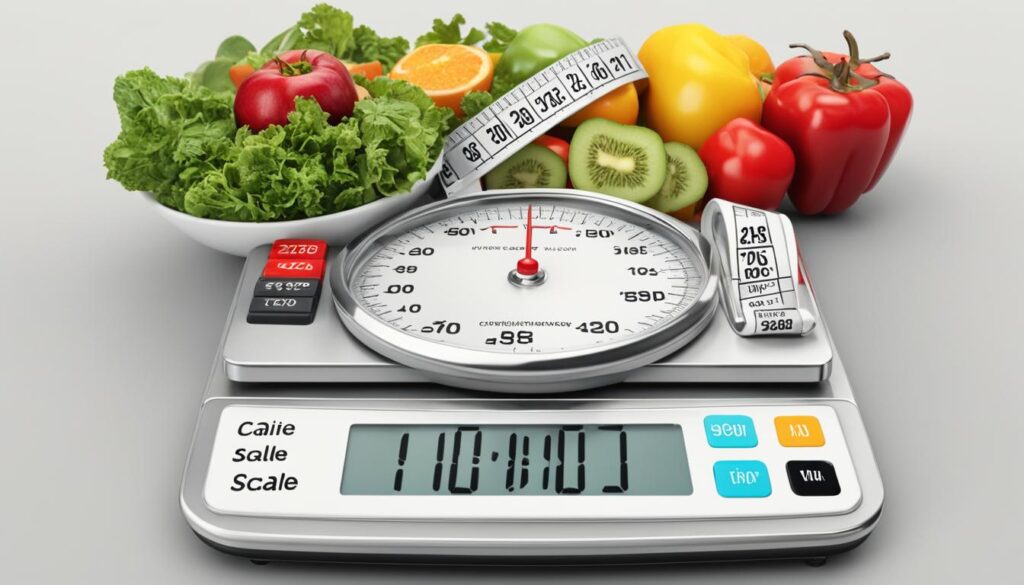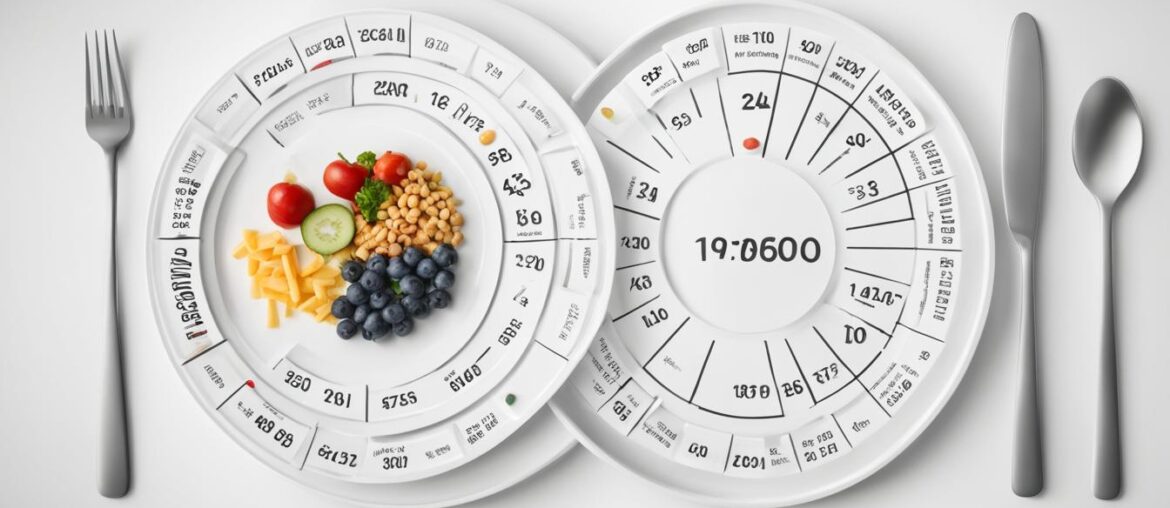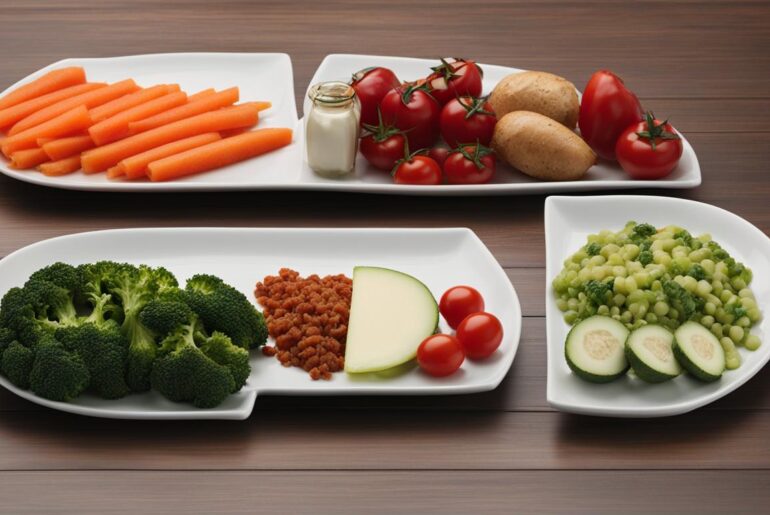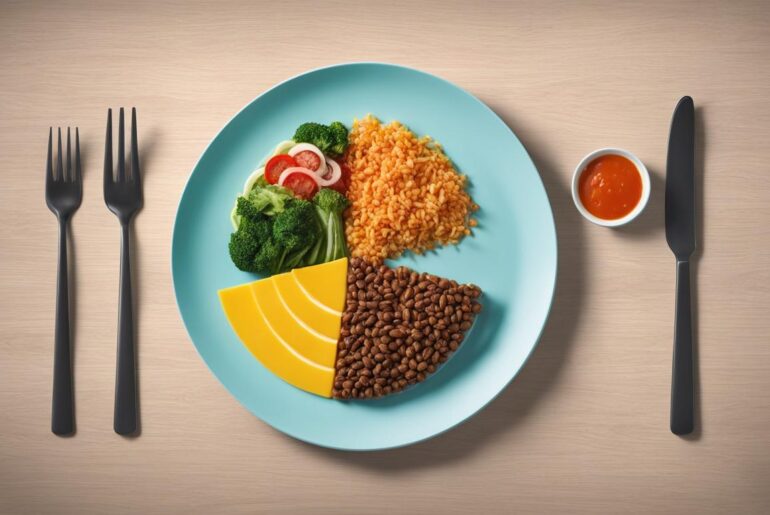When it comes to weight loss, finding effective strategies is crucial. Two key strategies that work synergistically to maximize weight loss and promote a healthier lifestyle are calorie counting and portion control. By monitoring your caloric intake and carefully controlling portion sizes, you can create a calorie deficit that leads to sustainable weight loss. This not only helps you shed unwanted pounds but also ensures that you are consuming the right amount of nutrients for a healthy, balanced diet.
Key Takeaways:
- Calorie counting and portion control work together to maximize weight loss
- Monitoring caloric intake and controlling portion sizes creates a calorie deficit
- Portion control is crucial for weight management and prevents overeating
- Calorie counting helps create awareness of nutritional intake and supports informed food choices
- Combining calorie counting and portion control promotes a healthier lifestyle and balanced diet
Importance of Portion Control for Weight Loss
Portion control plays a vital role in weight loss because it helps you manage the amount of food you eat and control your caloric intake. A portion refers to the amount of food on your plate, while a serving is an exact measure of food. By practicing portion control, you can train yourself to understand correct serving sizes and practice mindful eating.
Visual cues, such as using everyday objects to gauge serving sizes, can be helpful in developing portion control habits (see my post here). For example, a medium pepper is about the size of a baseball and equals one vegetable serving.
By becoming more mindful of portion sizes and practicing portion control, you can better manage your calorie intake and achieve your weight loss goals.
Calorie Counting: A Key Component of Weight Loss

Calorie counting is an essential tool for weight loss. By tracking your daily calorie intake, you can create a calorie deficit that promotes weight loss. This requires keeping a record of the calories in the foods you consume and being aware of portion sizes.
Meal planning and pre-tracking your meals can assist in maintaining a balanced diet and staying within your calorie goals. It allows you to plan nutritious meals that meet your specific calorie needs, ensuring you are getting the right amount of nutrients while staying on track with your weight loss journey (check out my post on weight loss journey here).
Calorie tracking apps and tools can help facilitate the process of calorie counting and provide valuable insights into your nutritional intake. They enable you to easily input the foods you eat and calculate their calorie content. Some apps even offer features like barcode scanning and recipe analysis to make tracking more convenient.
By incorporating calorie counting into your weight loss routine, you can develop a greater awareness of your eating habits and make informed choices to support your fitness goals. It helps you understand the impact of different foods on your overall calorie intake, making it easier to adjust your eating patterns and make healthier choices.
Remember, it’s important to consult with healthcare professionals or registered dietitians to develop an individualized calorie counting plan that aligns with your specific needs and goals.
Finding the Right Portion Sizes for Weight Loss
Determining the optimal portion sizes for weight loss can be challenging. It is important to differentiate between serving size and portion size. Serving size refers to the recommended amount of food according to the nutrition label, while portion size is the actual amount of food you consume.
When setting portion sizes for weight loss, it is crucial to consider your daily calorie goals. Calculating portion sizes based on your calorie goal can help you plan meals that are satisfying and aligned with your weight loss objectives.
The plate method is a helpful strategy for determining appropriate portion sizes. This method involves dividing your plate into sections: half should be filled with vegetables, one-quarter with protein, and one-quarter with whole grains or starchy vegetables. This visually balanced plate ensures that you are getting a good mix of nutrients while controlling portion sizes.
Using portion control dishes can also aid in managing the amount of food you consume. These dishes are designed with sections of specific sizes for different food groups, making it easier to control your portions and achieve your weight loss goals.
Measuring your food with a scale is another effective way to determine portion sizes. This allows you to be precise in your measurements and ensures that you are not unknowingly consuming larger portions than intended.
Practicing mindful eating can also help you establish appropriate portion sizes. By paying attention to your body’s hunger and fullness cues, you can better gauge how much food you actually need to feel satisfied.
Experimenting with different portion sizes and working with a registered dietitian can provide personalized guidance and support on finding the right balance for your weight loss journey.
Remember, incorporating portion control into your healthy eating plan is essential for weight loss. By finding the right portion sizes and sticking to them, you can achieve your calorie goals and maintain a balanced diet for long-term success.
Conclusion
In conclusion, the synergy between calorie counting and portion control is a powerful tool for weight loss and promoting a healthy lifestyle. By monitoring your caloric intake and practicing portion control, you can create a calorie deficit and achieve sustainable weight loss. Paying attention to serving sizes, using visual cues, and tracking your calorie intake are essential components of successful weight loss. With the right portion sizes and a balanced diet, you can maximize your weight loss efforts and foster a healthier lifestyle.
Remember to consult with healthcare professionals or registered dietitians for personalized guidance on caloric intake and portion control for your specific needs.




